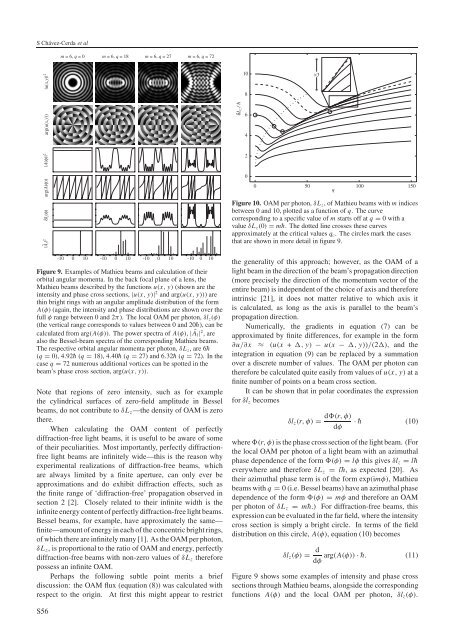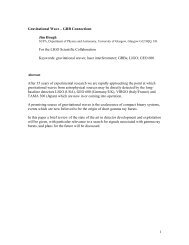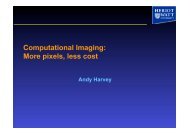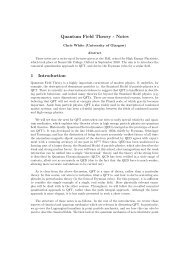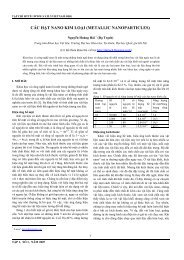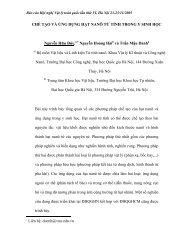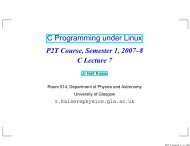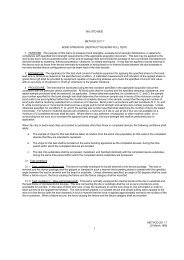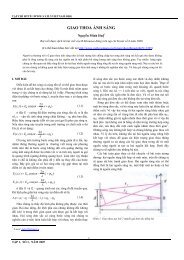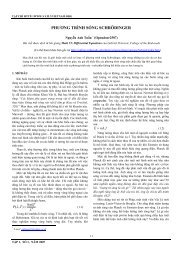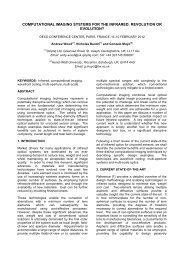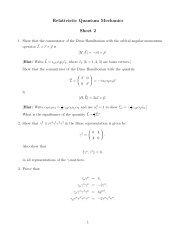Holographic generation and orbital angular momentum of high ...
Holographic generation and orbital angular momentum of high ...
Holographic generation and orbital angular momentum of high ...
Create successful ePaper yourself
Turn your PDF publications into a flip-book with our unique Google optimized e-Paper software.
SChávez-Cerda et alm = 6, q = 0m = 6, q = 18m = 6, q = 27m = 6, q = 72|u(x,y)| 2108×3arg(A(φ)) |A(φ)| 2 arg(u(x,y))δl z (φ)|A l | 2~δL z /64200 50 100 150qFigure 10. OAM per photon, δL z , <strong>of</strong> Mathieu beams with m indicesbetween 0 <strong>and</strong> 10, plotted as a function <strong>of</strong> q. Thecurvecorresponding to a specific value <strong>of</strong> m starts <strong>of</strong>f at q = 0 with avalue δL z (0) = m¯h. The dotted line crosses these curvesapproximately at the critical values q c . The circles mark the casesthat are shown in more detail in figure 9.-10 0 10 -10 0 10 -10 0 10 -10 0 10Figure 9. Examples <strong>of</strong> Mathieu beams <strong>and</strong> calculation <strong>of</strong> their<strong>orbital</strong> <strong>angular</strong> momenta. In the back focal plane <strong>of</strong> a lens, theMathieu beams described by the functions u(x, y) (shown are theintensity <strong>and</strong> phase cross sections, |u(x, y)| 2 <strong>and</strong> arg(u(x, y)))arethin bright rings with an <strong>angular</strong> amplitude distribution <strong>of</strong> the formA(φ) (again, the intensity <strong>and</strong> phase distributions are shown over thefull φ range between 0 <strong>and</strong> 2π). The local OAM per photon, δl z (φ)(the vertical range corresponds to values between 0 <strong>and</strong> 20¯h), can becalculated from arg(A(φ)). The power spectra <strong>of</strong> A(φ), |Ã l | 2 ,arealso the Bessel-beam spectra <strong>of</strong> the corresponding Mathieu beams.The respective <strong>orbital</strong> <strong>angular</strong> momenta per photon, δL z ,are6¯h(q = 0), 4.92¯h (q = 18), 4.40¯h (q = 27) <strong>and</strong> 6.32¯h (q = 72). In thecase q = 72 numerous additional vortices can be spotted in thebeam’s phase cross section, arg(u(x, y)).Note that regions <strong>of</strong> zero intensity, such as for examplethe cylindrical surfaces <strong>of</strong> zero-field amplitude in Besselbeams, do not contribute to δL z —the density <strong>of</strong> OAM is zerothere.When calculating the OAM content <strong>of</strong> perfectlydiffraction-free light beams, it is useful to be aware <strong>of</strong> some<strong>of</strong> their peculiarities. Most importantly, perfectly diffractionfreelight beams are infinitely wide—this is the reason whyexperimental realizations <strong>of</strong> diffraction-free beams, whichare always limited by a finite aperture, can only ever beapproximations <strong>and</strong> do exhibit diffraction effects, such asthe finite range <strong>of</strong> ‘diffraction-free’ propagation observed insection 2 [2]. Closely related to their infinite width is theinfinite energy content <strong>of</strong> perfectly diffraction-free light beams.Bessel beams, for example, have approximately the same—finite—amount <strong>of</strong> energy in each <strong>of</strong> the concentric bright rings,<strong>of</strong> which there are infinitely many [1]. As the OAM per photon,δL z , is proportional to the ratio <strong>of</strong> OAM <strong>and</strong> energy, perfectlydiffraction-free beams with non-zero values <strong>of</strong> δL z thereforepossess an infinite OAM.Perhaps the following subtle point merits a briefdiscussion: the OAM flux (equation (8)) was calculated withrespect to the origin. At first this might appear to restrictthe generality <strong>of</strong> this approach; however, as the OAM <strong>of</strong> alight beam in the direction <strong>of</strong> the beam’s propagation direction(more precisely the direction <strong>of</strong> the <strong>momentum</strong> vector <strong>of</strong> theentire beam) is independent <strong>of</strong> the choice <strong>of</strong> axis <strong>and</strong> thereforeintrinsic [21], it does not matter relative to which axis itis calculated, as long as the axis is parallel to the beam’spropagation direction.Numerically, the gradients in equation (7) can beapproximated by finite differences, for example in the form∂u/∂x ≈ (u(x + , y) − u(x − , y))/(2), <strong>and</strong> theintegration in equation (9) can be replaced by a summationover a discrete number <strong>of</strong> values. The OAM per photon cantherefore be calculated quite easily from values <strong>of</strong> u(x, y) at afinite number <strong>of</strong> points on a beam cross section.It can be shown that in polar coordinates the expressionfor δl z becomesδl z (r,φ)= d(r,φ)dφ· ¯h (10)where (r,φ)is the phase cross section <strong>of</strong> the light beam. (Forthe local OAM per photon <strong>of</strong> a light beam with an azimuthalphase dependence <strong>of</strong> the form (φ) = lφ this gives δl z = l¯heverywhere <strong>and</strong> therefore δL z = l¯h, as expected [20]. Astheir azimuthal phase term is <strong>of</strong> the form exp(imφ), Mathieubeams with q = 0 (i.e. Bessel beams) have an azimuthal phasedependence <strong>of</strong> the form (φ) = mφ <strong>and</strong> therefore an OAMper photon <strong>of</strong> δL z = m¯h.) For diffraction-free beams, thisexpression can be evaluated in the far field, where the intensitycross section is simply a bright circle. In terms <strong>of</strong> the fielddistribution on this circle, A(φ), equation (10) becomesδl z (φ) = d arg(A(φ)) · ¯h. (11)dφFigure 9 shows some examples <strong>of</strong> intensity <strong>and</strong> phase crosssections through Mathieu beams, alongside the correspondingfunctions A(φ) <strong>and</strong> the local OAM per photon, δl z (φ).S56


